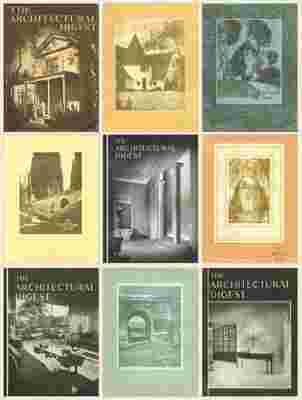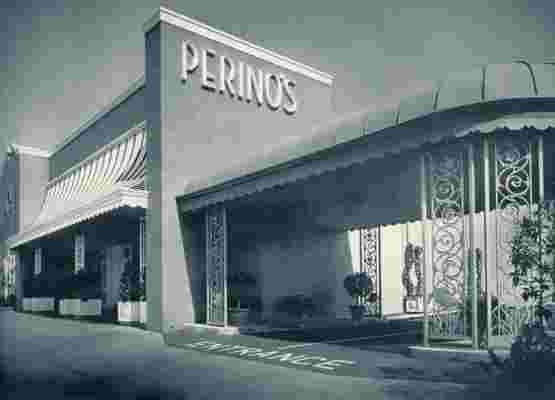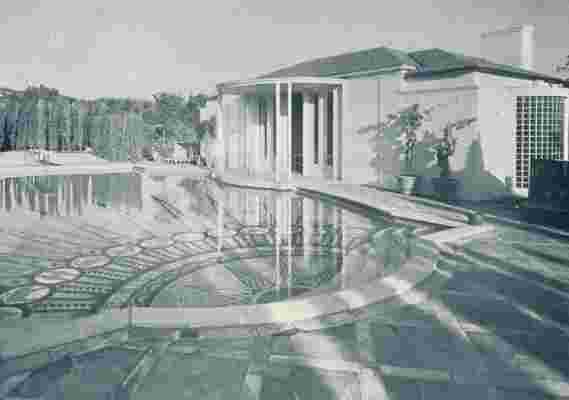June 22,2022
Paul R. Williams: Behind the Mastery of the Master Architect
by David Stewart
If you’re an avid reader of this publication, you’re likely familiar with the name Paul R. Williams. If Williams doesn’t ring a bell, we suggest you become acquainted. Paul Revere Williams (1894–1980) was a native son of Los Angeles who, from extremely modest beginnings, became one of the most prolific and accomplished architects in recent history. And he did all of this despite the fact that he faced significant prejudices simply because he was Black.
Paul Williams and AD are deeply intertwined. When the publication was first founded by James Coke Brasfield in 1920 (then called The Architectural Digest) , it was created to showcase noteworthy structures from talented Southern California architects and Williams’s designs featured prominently. The fourth and latest volume in a 12-part series entitled Master Architects of Southern California 1920-1940 hones in on Williams’s work, his life, and the indelible imprint he has left on American architecture as a whole.
Prominence in the Face of Oppression
The sheer volume of Williams’s oeuvre cannot be understated. His hand was present in over 3,000 projects. In 1940, Architect and Engineer wrote, “Probably no one architect on the Pacific Coast has achieved greater success in domestic architecture than Mr. Williams.” Williams wasn’t even at the midpoint of his career in 1940. He had yet to be crowned the “Architect to the Stars ” or develop the largest public housing project west of the Mississippi. That same article goes on to highlight his national recognition as “particularly noteworthy in view of the handicaps which Mr. Williams faced at the start of his career.”
In building his legacy, Williams’s race surely created many obstacles. There are numerous accounts of tactics he developed such as sketching upside down to accommodate his white clients and spare them the impropriety of standing shoulder to shoulder with a Black man. Other pieces praise him for breaking barriers of the color line in the American Institute of Architects . There is an entire episode on him for the Lost LA television series by PBS . Many projects are in place to renovate, restore, or extend his legacy . Recently, the USC School of Architecture and Getty Research Institute announced the joint acquisition of his archives and their plans to digitize and preserve the treasure trove of American architectural history. There is no shortage of evidence as to Williams’s remarkable life, his struggles with prejudice, and his unquantifiable triumphs. But none do quite what this book does: offer an extensive biography by exploring the rarely seen, early domestic projects that put Williams on his trajectory to becoming the greatest Black architect of the 20th century.

The book is complete with reproductions of original photographs from early AD publications.
A Multifaceted Legacy
“Williams is not just an important architect. He is not just an important architect of that era. He is really one of the most important American architects,” says Stephen Gee, one of the authors of the Williams volume. Frankly, it’s difficult to grasp the full scope of Williams’s impact because every facet of his story is so rich, it’s easy to get sidetracked. “His improbable rise to prominence is so profound that it eclipses other details of what made him important,” says Gee.
Janna Ireland, an award-winning photographer who has published her own book on Williams , echoes Gee, “talking about him as ‘Hollywood’s Architect’ obscures so much of the other work that he was doing. He was working through so many different eras, for people who were low-income or middle-class, and participated in different municipal projects.”
Williams’s story has become so focused on who he designed for (the likes of Lucille Ball and Frank Sinatra) and the color of his skin that his artistry and attention to detail become somewhat overlooked. This volume refocuses his talent, allowing the reader to follow along as Williams develops his imitable design.

Perino's was a restaurant designed by Paul R. Williams, and became a hangout for the L.A. elite.
Creating the California Style
The time frame of the book, 1920 to 1940, concerns when California was developing its identity. Post–Gold Rush, between two world wars, giving birth to Hollywood and in the midst of the Great Migration; the state was molding its modern personality and morphing from rural and expansive farmland into homesteads, metropolises, and industries. For a man with great imagination and adaptive skill sets, this created a playground. According to Gee, “Williams existed as an architect in a time when people were experimenting and trying to figure out what a California style is. What is a California structure supposed to look like?” To turn the pages of this book is to take a trip, chronologically, through the evolution of Los Angeles and building techniques—steered by one man. As Ireland says, “When we think about glamour and Los Angeles, we’re thinking about these styles that Paul Williams helped define.”
The demand for so many new and different kinds of structures allowed Williams to demonstrate his multitude of talents and interests. An employee of Williams, Jeh V. Johnson described him as a “master of creative eclecticism.” “I think that’s a wonderful way of describing him. You could literally come to him with anything, any crazy idea, and he would turn it into something architecturally pleasing,” says Gee. This is where the brilliance of Williams shines—he would give his clients what they wanted, but it would be exactly what he wanted as well. He was adamant, Ireland writes in her book, that “he built homes, not houses.”
One of his most enduring domestic design elements was to move the dining room to the back of the house and the kitchen to the front, a reversal of the norm. Residents could then enjoy their gardens and backyards when relaxing, but keep watch on the street or front porch when preparing meals. You can see this change happening in the book in the late 1930s. Williams had a strong ability to place himself in the position of a client and design for them in a way that truly envisioned the life of this particular person or family. As a result, his homes are wholly singular without compromising familiarity and invitation.

Williams had an instinct for what a client desired in a home. His designs became so popular that American residential architecture would forever have a different look and feel.
Signature Williams
When asked how to describe Williams’s work, both Gee and Ireland are hesitant to supply adjectives, citing a disservice to his nuance and breadth. Ireland eventually offers “graceful,” “assured,” “meticulous,” and “nimble.” Gee says that the residences featured in the book exude “a confident, warm, casual elegance,” but cannot state anything to Williams’s work overall. “That’s part of the compliment you pay to him. When you consider his full body of work, it’s hard to pigeonhole him. The variety of styles that he works in is almost too vast.”
In looking through the residences presented in this book—complete with reproductions of the rare, original photographs from early The Architectural Digest publications (many shot by Julius Shulman), floor plans, lists of former owners, and context for the original clients and interior designers—it’s exciting to see the groundwork for what would become Williams’s design foundation. The careful use of the undulating curves and bold lines that become his signature. The ways in which he places mirrors and hallways to create homes with a personality all their own. Foyers that invite and simultaneously hypnotize with a gentle bend of a staircase. His stamp is ever present but never quite the same, a style that is undefinable yet completely recognizable.






